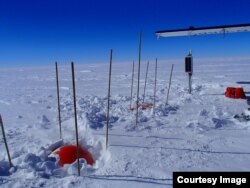The U.S. government shutdown has reached the end of the Earth.
The National Science Foundation, which receives its budget from the federal government, announced that it will shut down its three stations in Antarctica.
This means research that would have been done during the summer season that began October 1 is now on hold. The loss could be both scientific and financial.
Cash flow
The National Science Foundation has run out of money. It cannot go forward without its proposed $465 million budget. In a statement on its website, the NSF announced, “all field and research activities not essential to human safety and preservation of property will be suspended.”
That is bad news for Samantha Hansen, assistant professor of geological sciences at the University of Alabama. Last year, her team deployed 15 seismic stations in an Antarctic mountain range to study earthquakes. She had planned to return this season to collect the data.
“If we can’t get down there and if any of the stations are not operating as they should right now, if they have any problem, we’re not going to be able to fix them, because we can’t get there," Hansen said. "And if we can’t fix them, they are not going to run correctly into the upcoming year and we can potentially lose all of that officiated data.”
Lost data and equipment
Hansen runs the risk of losing both the data and the costly equipment. Located in areas of high snowfall, the sensors would be completely buried and inaccessible by the time next season arrives.
“And obviously for the project, it would be a huge loss because we would basically have nothing to work on," she said. "So it’s kind of critical for us, both in terms of the data and taking care of the equipment and being able to work on our research projects of getting back there.”
Researchers in a wide variety of disciplines face that dilemma. Joanne Carney, who follows science policy as director of the Office of Government Relations for the American Association for the Advancement of Science, says legislators' failure to reach an agreement has put an entire research season in limbo for hundreds of projects that can only be done in Antarctica's pristine environment.
“This impacts a whole host of disciplines from biological studies of animals like penguins, astronomical research as well as long-term research on climate change and weather,” Carney said.
Starting from scratch
For these scientists, the shutdown is more than simply a temporary work stoppage.
“There are many areas of science that involve continuous monitoring and interpretation of scientific data, for example in climate change and weather, and so while policy makers in [Washington] DC may view the budget impasse as a hiatus, that doesn’t translate the same for science," she said. "For science it means throw away your research and start from scratch.”
That's why scientists like Hansen are anxiously waiting for Congress to act. In its statement, however, the National Science Foundation cautioned, “Some activities cannot be restarted once seasonally dependent windows for research and operations have passed, the seasonal workforce is released, science activities are curtailed and operations are reduced.”
Even so, Hansen remains somewhat optimistic.
“I think that there is a lot of hope that once the shutdown is resolved and budgetary issues get taken care of, they will salvage at least part of the field season and maybe we’ll still get to do what we want to do,” she said.
But the clock is ticking. The short Antarctic research season runs from October through February.
The National Science Foundation, which receives its budget from the federal government, announced that it will shut down its three stations in Antarctica.
This means research that would have been done during the summer season that began October 1 is now on hold. The loss could be both scientific and financial.
Cash flow
The National Science Foundation has run out of money. It cannot go forward without its proposed $465 million budget. In a statement on its website, the NSF announced, “all field and research activities not essential to human safety and preservation of property will be suspended.”
That is bad news for Samantha Hansen, assistant professor of geological sciences at the University of Alabama. Last year, her team deployed 15 seismic stations in an Antarctic mountain range to study earthquakes. She had planned to return this season to collect the data.
“If we can’t get down there and if any of the stations are not operating as they should right now, if they have any problem, we’re not going to be able to fix them, because we can’t get there," Hansen said. "And if we can’t fix them, they are not going to run correctly into the upcoming year and we can potentially lose all of that officiated data.”
Lost data and equipment
Hansen runs the risk of losing both the data and the costly equipment. Located in areas of high snowfall, the sensors would be completely buried and inaccessible by the time next season arrives.
“And obviously for the project, it would be a huge loss because we would basically have nothing to work on," she said. "So it’s kind of critical for us, both in terms of the data and taking care of the equipment and being able to work on our research projects of getting back there.”
Researchers in a wide variety of disciplines face that dilemma. Joanne Carney, who follows science policy as director of the Office of Government Relations for the American Association for the Advancement of Science, says legislators' failure to reach an agreement has put an entire research season in limbo for hundreds of projects that can only be done in Antarctica's pristine environment.
“This impacts a whole host of disciplines from biological studies of animals like penguins, astronomical research as well as long-term research on climate change and weather,” Carney said.
Starting from scratch
For these scientists, the shutdown is more than simply a temporary work stoppage.
“There are many areas of science that involve continuous monitoring and interpretation of scientific data, for example in climate change and weather, and so while policy makers in [Washington] DC may view the budget impasse as a hiatus, that doesn’t translate the same for science," she said. "For science it means throw away your research and start from scratch.”
That's why scientists like Hansen are anxiously waiting for Congress to act. In its statement, however, the National Science Foundation cautioned, “Some activities cannot be restarted once seasonally dependent windows for research and operations have passed, the seasonal workforce is released, science activities are curtailed and operations are reduced.”
Even so, Hansen remains somewhat optimistic.
“I think that there is a lot of hope that once the shutdown is resolved and budgetary issues get taken care of, they will salvage at least part of the field season and maybe we’ll still get to do what we want to do,” she said.
But the clock is ticking. The short Antarctic research season runs from October through February.











